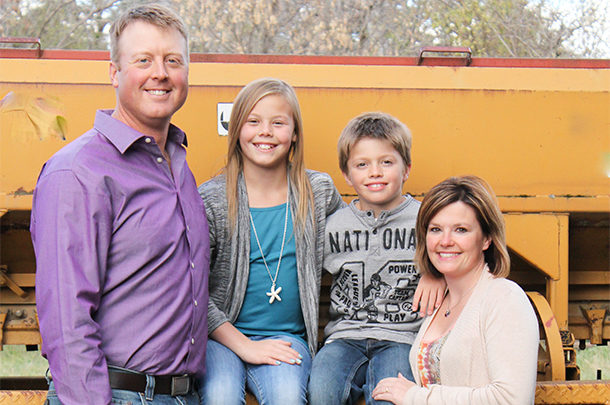After selling the family’s 200-head cow herd nearly seven years ago, Axten has been able to focus his efforts on crops and soil health. Since that time, he has not only eliminated tillage, but has added a diverse rotation of warm- and cool-season crops, several blends of cover crops, no disturbance seeding and an intercropping system.
“Selling our cow herd and focusing on crops was probably one of the better things that happened on Axten Farms,” he says. “It wasn’t something we had planned on, but we knew something had to give. When we started implementing some of these practices, we saw improvements in the soil that we didn’t think were possible. Our biggest goal was to increase our yields and profitability, and we now know the best strategy for that is to increase our organic matter, and with that the biological activity will follow.”
Axten owns and manages close to 7,000 acres of diverse farmland in Saskatchewan, near the North Dakota border. The northern region of the farm is primarily farm country with 65 percent clay soil, while the southern region lies along the edge of cow country with rolling hills and sandy clay loam soil. Durum wheat, oats and rye are his predominant cereals, with mustard and red lentil intercrop, forage peas and mustard intercrop, flax and chickpea intercrop, and large green lentils, faba beans and fenugreek as composition crops. He also grows 280 leased acres of alfalfa hay and contract grazes 300 head of brood cows on more than 900 acres of cover crops in the fall and winter.

As a cover crop, he focuses on a blend of cereal rye, tillage radish, turnips, chickling vetch, flax, teff and red clover. He says diversity in the blend and rotation of grain crops has been integral in increasing factors such as microbial activity, drought tolerance and nutrient cycling.
“We love the activity the cows give to the land,” Axten says. “The trampling effect and the biology of the rumen we are cycling through and getting back to the soil surface are all things we want happening on our land, but you can’t replicate it with a piece of equipment. We are super fortunate to have good neighbors who are flexible and make the grazing system work both ways.”
Axten also mentions that they tried a full-season graze a few years back, but had little success. Like many graziers, Axten left the cows in the rotation too long and ended up taking most of the crop residue that year. He says if they were to do it again, they would make sure to leave anywhere between 60 and 70 percent of the residue behind for cover.
“For some reason, people have the tendency to think they can get a little bit more out of their rotation,” Axten says. “Going forward, we have learned with our grazing that as soon as we become even a slightly bit concerned that we are taking too much, we need to move them because we probably are.”
Axten credits most of his success to keeping the soil covered throughout the year, whether it’s through cover cropping, crop residue or a combination of the two. Through experience he has found that covered soil buffers temperature, reduces moisture loss, protects against erosion, reduces weed competition and provides habitat for soil biology.
Citing research conducted by the USDA in Kerrville, Texas, Axten points out when soil temperatures reach 100°F, it can lose 85 percent of its moisture through evaporation and transpiration. Likewise, when soil temperatures reach 130ºF, 100 percent of moisture is lost, and at 140ºF the soil bacteria die.

“For a lot of farmers, moisture is the number one limiting factor,” Axten says. “Anything you can do to keep moisture in store for a time when you don’t have it but you need it can be the making rate. We were so dry this year, but it was amazing to see that when I brushed back the crop residue, there was still some moisture left at the surface.”
In addition to keeping the soil covered, Axten realizes that mycorrhizae fungi, or extensions of the root system, are a crucial foundation for healthy soils. These filaments have a mutually beneficial relationship with plants and are more effective in water and nutrient absorption than the roots themselves.
Axten has found that the mycorrhizae not only exchange nutrients with the plant, but they can reach further into the soil and send water and nutrients back to the plant when its reserves are depleted. Because of this, he believes that is why he was able to grow a crop on 2 inches of precipitation in 2015.
“Mycorrhizae are our best friend, and growers who don’t know what mycorrhizae are need to find out,” he says. “It’s what makes this whole no-till thing tick. The reason we need to do no-disturbance seeding is so we don’t disturb the mycorrhizae. When you till, you’re encouraging moisture loss and reducing oxygen; this creates a fast flush of bacteria who burn up your organic matter. The less tillage you can do, the better.”
It may sound like Axten has mastered the art of soil health, but he humbly admits that it is a life-long pursuit, one that will probably never be fully reached. For him, it’s not a matter of sustaining his resources; it’s about improving year after year. FG
PHOTO 1: The Axten family from left to right: Derek, Kate, Brock and Tannis.
PHOTO 2: The cows are mob grazing a blend of oats, triticale, forage peas, radish, turnip, chickling vetch and clover.
PHOTO 3: Below crop residue, the soil has a significantly lower temperature than bare soil. The soil temperature in this photo reads 81°F. Photos provided by Derek Axten.













